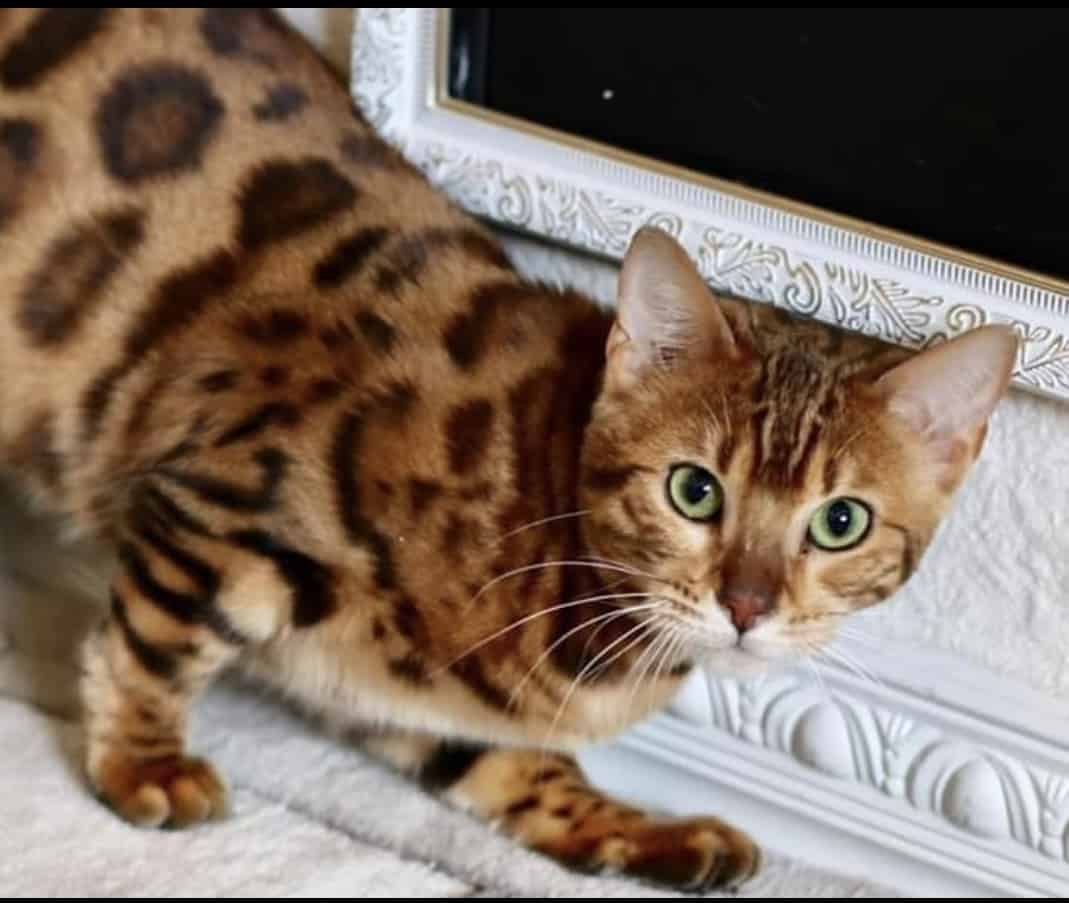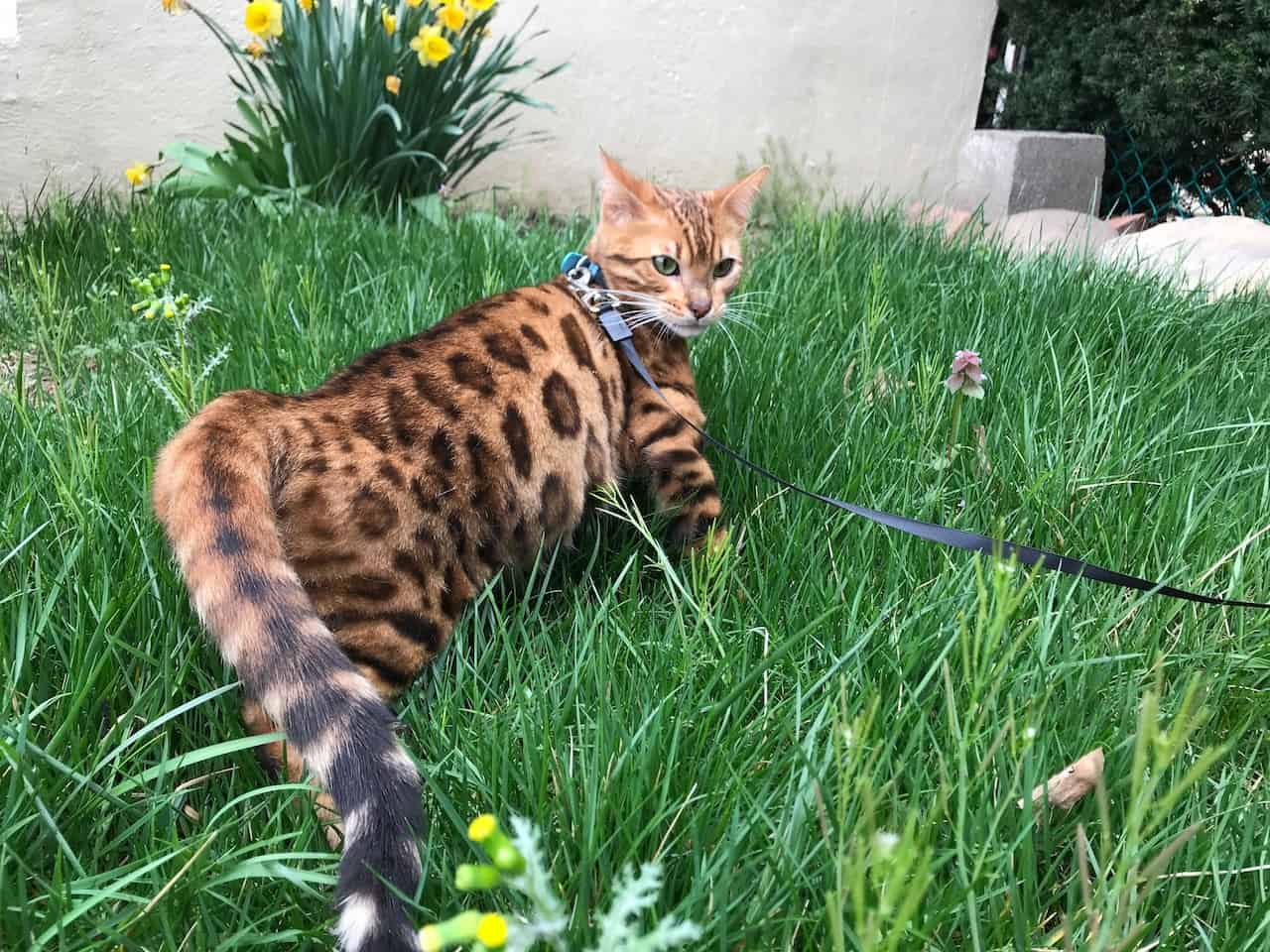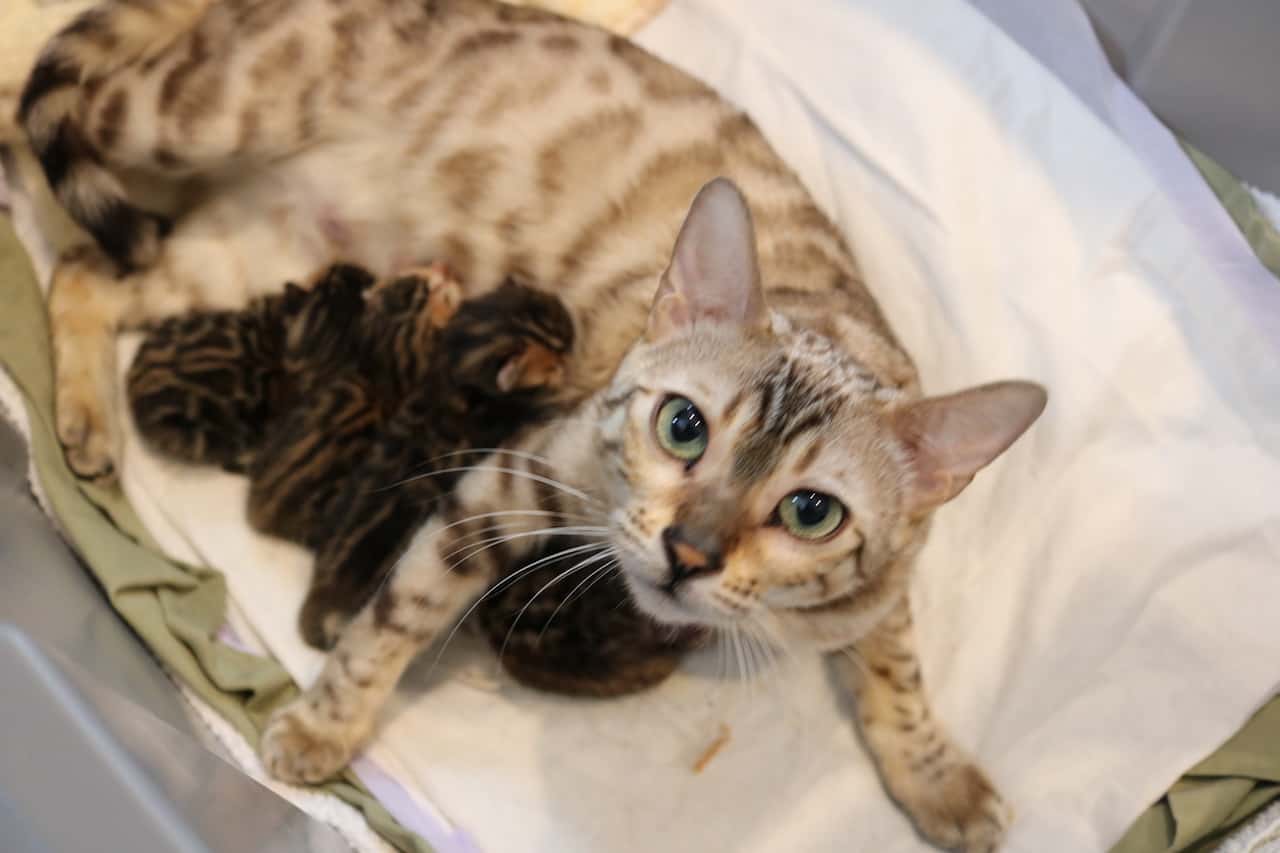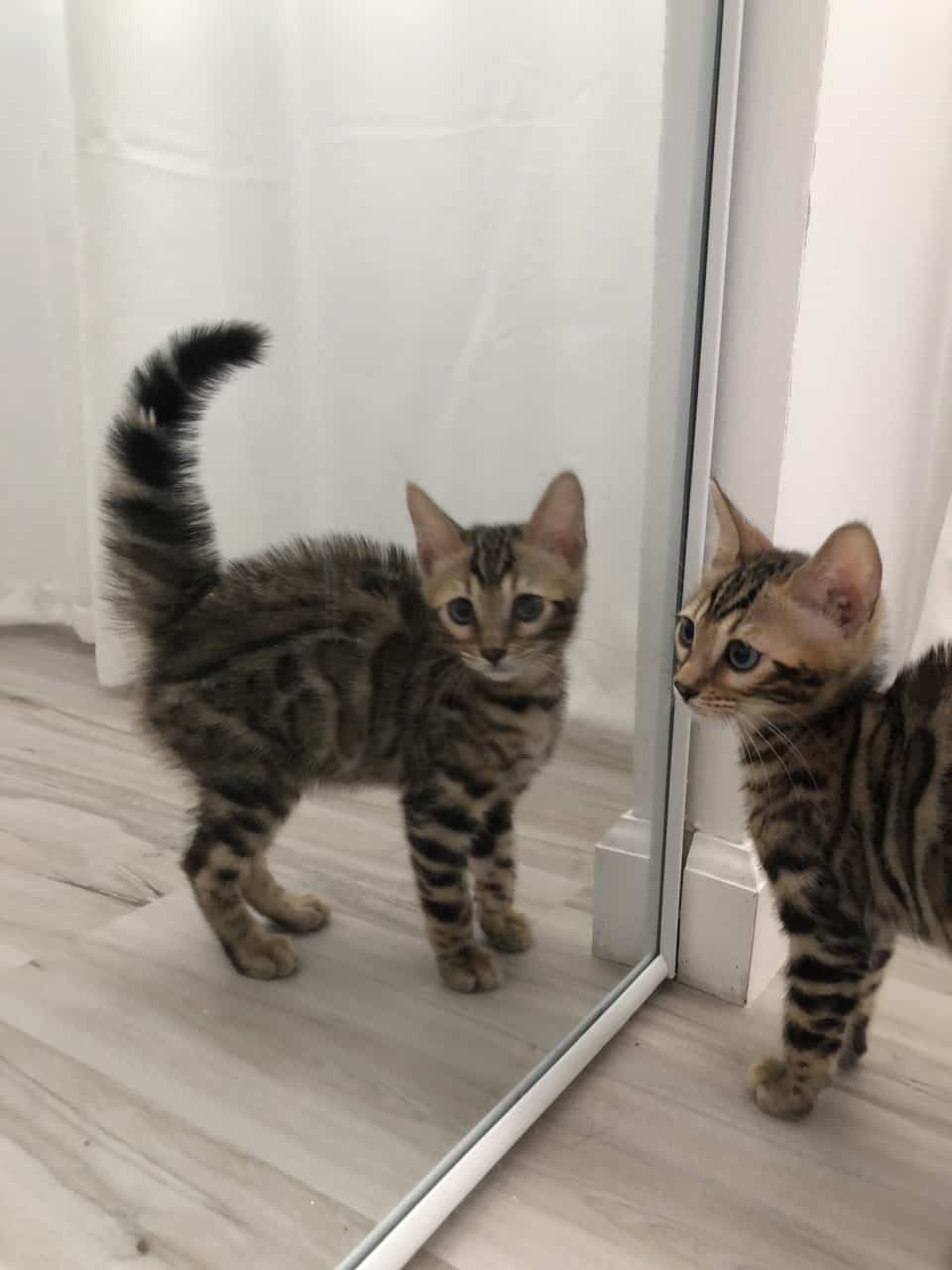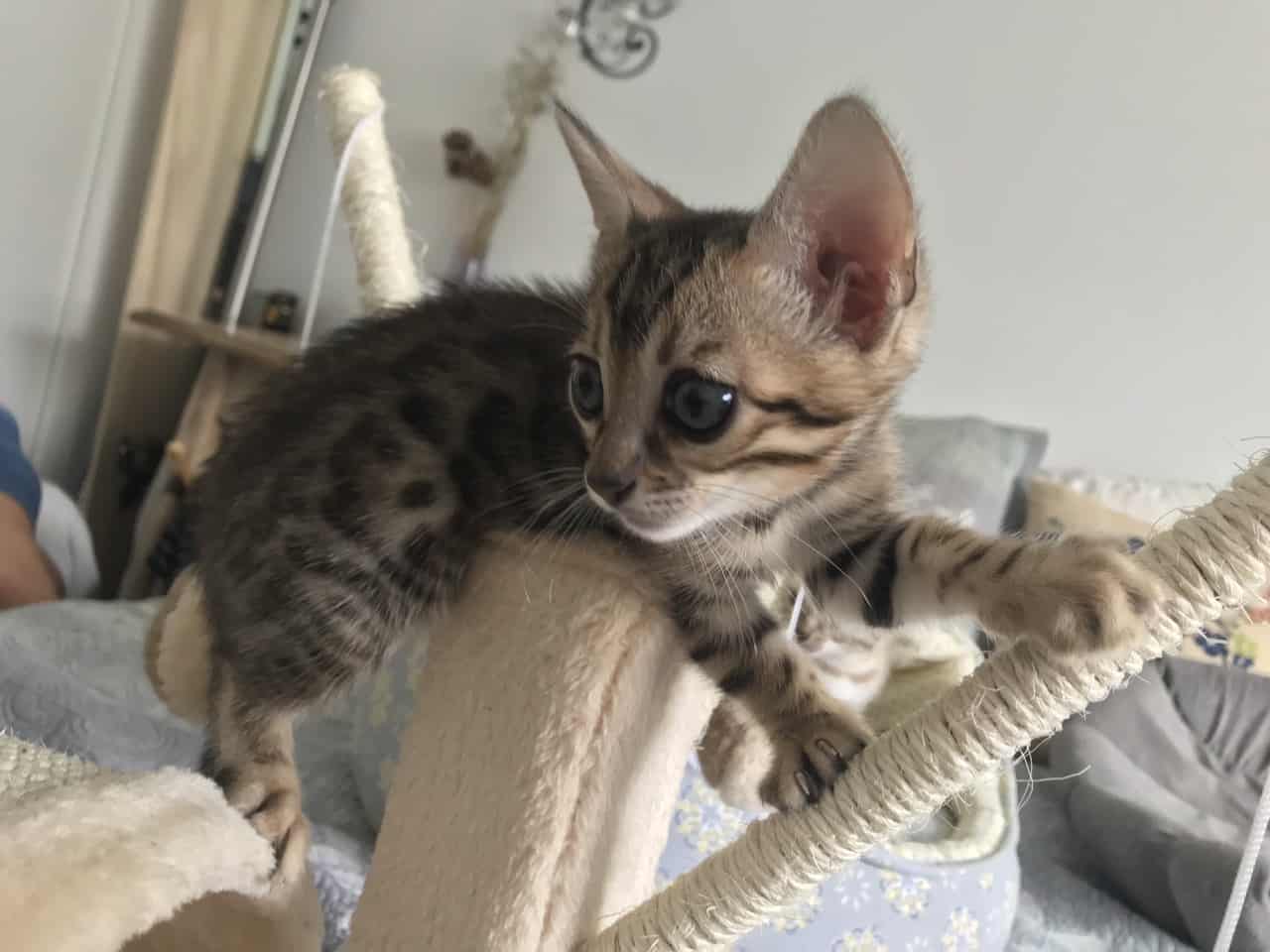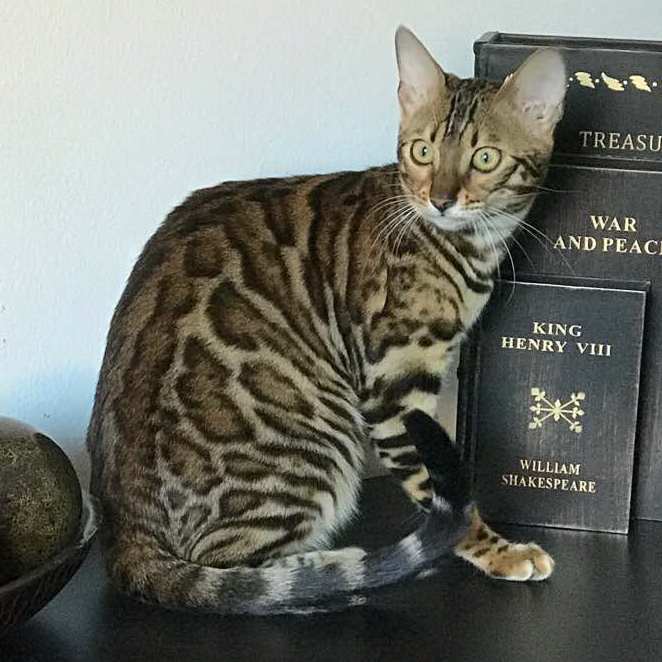About Bengals
History
With his distinctive spotted coat and large size, the Bengal looks like a wild cat on the prowl, but although one of his ancestors is the small, wild Asian leopard cat, he’s a domestic cat through and through.
Bengals take their name from the Asian leopard cat’s scientific name, Felis bengalensis. They were created through crosses between an Asian leopard cat — which in the 1950s and into the 1960s could be purchased at pet stores — and domestic shorthairs. Jean Mill, a breeder in California, was the first to make such a cross, but not because she wanted to create a new breed. She had acquired a leopard cat and allowed her to keep company with a black tom cat so she wouldn’t be lonely. To her surprise, since she hadn’t thought the two species would mate, kittens resulted, and Mill kept a spotted female. Breeding her back to her father produced a litter of spotted and solid kittens.
At about the same time, Dr. Willard Centerwall was crossing Asian leopard cats with domestic cats at Loyola University. The leopard cats were resistant to the feline leukemia virus, so researchers were interested in finding out if the trait could be passed on to hybrid offspring.
Various breeders became interested in developing the cats as a breed. Mill was one of them. Changes in her life had caused her to give up cat breeding, but she was ready to begin again. She had acquired some of Dr. Centerwall’s hybrids and sought out suitable males to breed to them. One was an orange domestic shorthair that she found in India, of all places, and the other was a brown spotted tabby acquired from a shelter. Bengals today are considered to be one and the same with domestic cats, and any Bengal purchased should be at least four generations removed from any ancestors with wild bloodlines.
The first cat association to recognize the Bengal was The International Cat Association, which granted the breed experimental status in 1983, followed by full recognition in 1991. The Bengal is also recognized by the American Cat Fanciers Association, the Canadian Cat Association and the United Feline Organization.
Bengal cats are so sought after, that a British woman paid over $50,000 for her bengal cat in 1990, dubbing them the “Rolls Royce” of feline companions.
Size
This is a large cat. Bengals weigh 8 to 15 pounds or more.
Personality
The Bengal is highly active and highly intelligent. This makes him fun to live with, but he can sometimes be challenging. On the whole, the Bengal is a confident, talkative, friendly cat who is always alert. Nothing escapes his notice. He likes to play games, including fetch, and he’s a whiz at learning tricks. His nimble paws are almost as good as hands, and it’s a good thing he doesn’t have opposable thumbs or he would probably rule the world. Bored bengal cats can also adopt some unconventional (and slightly destructive) habits, including: turning light switches on and off, fishing seals out of drains and excitedly plucking CDs from your DVD player.
Fond of playing in water, the Bengal is not above jumping into the tub or strolling into the shower with you. Aquarium and pond fish may be at risk from his clever paws. He also loves to climb and can often be found perching at the highest point he can reach in the home. A tall cat tree or two is a must for this feline, as are puzzle toys that will challenge his intelligence.
On the rare occasions that he isn’t swinging on chandeliers or swimming in your pool, the affectionate Bengal will be pleased to sit on your lap. It goes without saying that he will share your bed. And yes, he steals the covers.
Health
Both pedigreed cats and mixed-breed cats have varying incidences of health problems that may be genetic in nature. Bengals are generally healthy, but the following diseases have been seen in the breed:
Distal neuropathy, a nervous system disorder that causes weakness. It can occur in Bengals as early as 1 year of age. Fortunately, many cats recover on their own, although a few relapse.
Flat-chested kitten syndrome, a deformity that can range from mild to severe. Kittens who survive to adulthood usually show no signs once they reach maturity.
Hip dysplasia, which in severe cases can cause lameness
Hypertrophic cardiomyopathy, a form of heart disease that is heritable in some breeds.
Patellar luxation, a hereditary dislocation of the kneecap that can range from mild to severe. Severe cases can be alleviated with surgery.
Progressive retinal atrophy, a degenerative eye disease.
Care
The short, thick coat of the Bengal is easily cared for with weekly combing to remove dead hair and distribute skin oils. A bath is rarely necessary.
Brush the teeth to prevent periodontal disease. Daily dental hygiene is best, but weekly brushing is better than nothing. Trim the nails every couple of weeks. Wipe the corners of the eyes with a soft, damp cloth to remove any discharge. Use a separate area of the cloth for each eye so you don’t run the risk of spreading any infection. Check the ears weekly. If they look dirty, wipe them out with a cotton ball or soft damp cloth moistened with a 50-50 mixture of cider vinegar and warm water. Avoid using cotton swabs, which can damage the interior of the ear.
Keep the litter box spotlessly clean. Cats are very particular about bathroom hygiene, and a dirty box may cause them to start using other places in the house instead.
It’s a good idea to keep a Bengal as an indoor-only cat to protect him from diseases spread by other cats, attacks by dogs or coyotes, and the other dangers that face cats who go outdoors, such as being hit by a car. Keeping him indoors also protects local birds and wildlife from this avid hunter. If possible, build your Bengal a large outdoor enclosure where he can jump and climb safely. Bengals who go outdoors also run the risk of being stolen by someone who would like to have such a beautiful cat without paying for it.
Coat Color And Grooming
The Bengal could never be called delicate. He is an athlete: agile and graceful with a strong, muscular body, as befits a cat who looks as if he belongs in the jungle. His broad head is a modified wedge shape, longer than it is wide, with rounded contours. Atop it are medium-size to small ears that are relatively short, set toward the side of the head. Large oval eyes are almost round. Joining the head to the body is a long, muscular neck. Supporting the body are medium-length legs, slightly longer in the back than in the front, with large, round paws. A thick, medium-length tail tapers at the end and is tipped in black. When a Bengal rolls over, you can see that another characteristic is a spotted belly.
Enhancing the Bengal’s wild appearance is a short, thick pelt that feels luxuriously soft and silky. It comes in several colors and patterns, including brown tabby, seal mink tabby, black silver tabby, and seal silver lynx point. The coat can be spotted randomly or in horizontal patterns, or it can be marbled, with horizontal stripes arranged randomly on a lighter background. Some Bengals have a coat that is described as “glittered.” The fur shimmers in the light, as if it were tipped with gold dust.
Children And Other Pets
The active and social Bengal is a perfect choice for families with children and cat-friendly dogs. He will play fetch as well as any retriever, learns tricks easily and loves the attention he receives from children who treat him politely and with respect. He’s smart enough to get out of the way of toddlers but loves school-age children because they are a match for his energy level and curiosity. Nothing scares him, certainly not dogs, and he will happily make friends with them if they don’t give him any trouble. Always introduce any pets, even other cats, slowly and in a controlled setting.
Like many active cats, bengals have a high prey drive and should not be trusted with smaller prey animals such as: hamsters, smaller rabbits and guinea pigs.
